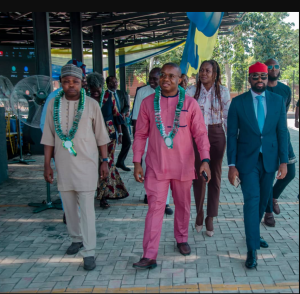
The steady decline of coal production in the United States over the past decade means that workers and local economies heavily dependent on income from coal must find new solutions. Thanks to the good ideas of local nonprofits — and to an influx of federal and state funds — projects such as turning West Virginia coal mines into greenhouses that offer fresh food to diabetes patients, launching training programs in sustainable trades on the Crow Reservation in Montana, and expanding West Virginians’ access to broadband (and thus to remote job opportunities and distance learning) have seen the light of day.
Recent legislation has made hundreds of billions of dollars of federal and state funds available to help communities shift from coal-based energy production to more renewable power. Last year’s $739 billion federal Inflation Reduction Act is just one of the many potential funding sources.
Today’s bounty makes Just Transition Fund’s methods look particularly prescient. A philanthropic organization founded in 2015, it focuses solely on coal communities in economic distress. Just Transition Fund has helped local nonprofits gain access to $360 million in public and private funds in such regions as Appalachia; the western and southwestern states, including tribal lands; and the Midwest, which encompasses mining and coal-plant communities in the Illinois Basin.
Just Transition Fund finds local organizations with practical strategies on how to jump-start economic activity. Over its seven-year lifespan, the fund’s local partners have created 524 businesses and more than 2,800 jobs, trained 11,000 workers, and provided broadband access to 18,000 households in areas where one-third of residents cannot access high-speed internet.
It doesn’t tell coal communities what they should do — and even avoids making the case that they must transition away from coal, according to executive director Heidi Binko. Instead it boosts organizations with direct grants, one-on-one consultations, and aid in navigating the complicated byways of applying for state and federal grants.
A West Virginia coalition focused on renewable-energy technology got a huge lift — with Just Transition Fund’s help — last fall when it was awarded $63 million from the U.S. Economic Development Administration’s American Rescue Plan. The ACT Now Coalition was one of 21 national winners of the $1 billion Build Back Better Regional Challenge, aimed at boosting economic recovery after the pandemic.
Before receiving the multimillion-dollar federal grant, ACT Now first raised a $26 million matching commitment from Bloomberg Philanthropies, the Claude Worthington Benedum Foundation, and Just Transition Fund, among others.
Still exhilarated by the news, Brandon Dennison, a leader of the ACT Now Coalition, celebrates his group’s homegrown roots and its plan to help train local workers in such fields as green construction and solar power.
“Straight from the heart of the coal fields of West Virginia,” Dennison says. “That’s what I’m the most proud of.”
Drawing Power From Power
Heidi Binko grew up in a small town in western New York, where her aunt worked in a coal plant for 40 years. She had relatives who were coal miners in West Virginia.
In 2015, Binko was working for the Rockefeller Family Fund on coal-related climate projects and Sandra Mikush represented the Appalachia Funders Network. The two began the program — supported by Rockefeller and the Appalachia network — that would become the Just Transition Fund.
Six partners — the Blue Moon Fund and the Chorus, Hewlett, JPB, Mary Reynolds Babcock, and Mertz Gilmore foundations — supported what would later become the Just Transition Fund with an initial $500,000, raised in just eight weeks. In 2017, Binko became the full-time executive director of the Just Transition Fund, when it separated from the Rockefeller Family Fund.
The idea for the Just Transition Fund was born when the Obama administration created the first federal program to help regions hurt by the shift away from coal, the Power Initiative. When Binko and colleagues with similar interests heard about the Power program, they began working closely with the White House to help develop the program.
Once the White House program made Power money available, Binko knew they had to do more: “We knew that we had to do something as philanthropists to try to help communities access the funds.”
She also knew from experience that local groups often do not have the staff or specialized skills to navigate the complex process of applying for federal grants. A crucial part of Just Transition’s role — and of philanthropy’s role in general, Binko feels — is to help local nonprofits find federal money, which in turn can attract private-sector investment, allowing a locality’s projects to eventually become self-sustaining.
And though she was inspired by the innovation she saw in places that relied on coal, she felt philanthropies were just not doing enough to help local organizations address the economic devastation created by closing coal mines and plants.
“Climate funders were thinking about reducing emissions, and they were thinking about how to close coal plants,” Binko says. “But what climate funders were not really thinking about is what’s going to happen to these communities from an economic perspective.”
The Crow Reservation, in Montana, for example, with a population of 7,900, depended on coal tax revenues to fund the reservation’s government and local economy. With a dramatic decline in revenue, the Crow government had to cut more than 1,000 of 1,300 jobs in 2017. A $40,000 Just Transition Fund matching grant helped Little Big Horn College, a community college on the reservation, access $1.2 million in Administration for Native Americans funds to start training programs for sustainable jobs not dependent on coal, such as in the electrical, plumbing, and carpentry trades.
A Multipronged Approach
Just Transition Fund has taken a purposefully wide-ranging approach to everything from its broad spectrum of funders in different sectors to its own organizational structure. Regarding the latter, Binko said she was inspired by the Rockefeller Family Fund’s dual role as both a grant maker and an organization that runs its own programs.
She explains that grant makers, because of contact with people nationwide, have a bird’s-eye view of an issue, whereas running local programs gives nonprofits a ground-level appreciation of what communities need. “When you pair those things together, you have a really powerful combination. Almost like bottom-up and top-down.”
Just Transition has helped local groups access $360 million in public and private funding, using $15 million of the fund’s seed money, to address issues such as food deserts, attracting new businesses and job opportunities, expanding broadband access, reclaiming former extraction sites, and improving health care in mostly rural areas.
Natalie Roper, director of special projects at Just Transition Fund, has worked there for about a year. Before then, she was executive director at Generation West Virginia, a Just Transition grantee focused on attracting and keeping young people in the state. What she saw there, above all, is that the decline of the coal industry impacts everything: “When a state economy relies on a single industry, that shapes the future for generations to come, whether you’re a miner or not.”
Expanding broadband access became an essential part of Generation West Virginia’s work, Roper says, and research supports the importance of broadband to the revitalization of rural coal communities. Smooth internet access is essential to searching for jobs, accessing distance learning, and simply “being a part of our democracy,” Roper says. Generation West Virginia raised $45 million in state and federal funds to connect 30,000 homes. Roper continues to work on the issue of broadband access, and her efforts in West Virginia serve as a national model for other Just Transition partners.
Just Transition Fund’s own programs span the gamut. For starters, it offers grants to some local partners — among the barriers to federal funding is the necessity, often, of having to raise substantial matching grants. It also provides personalized guidance to local organizations and hosts regional and national “convenings,” as Just Transition calls annual meetings, so partners can share stories and solutions.
ACT Now’s Dennison was at the first such meeting in 2015, in Washington, D.C.
“I’ll never forget it because there was just a palpable energy in that room,” he recalls. “Just the sense of connection that coal communities felt.” Though he might have been in an “Appalachian silo,” he was inspired when he met people from Western or Native American coal regions. Though there were important differences between them, he felt “a sense of community.”
Dennison also served on another Just Transition project, which was important to its aim of ensuring that local communities drive federal policy — its National Economic Transition committee. Gathering local, tribal, labor, and nonprofit leaders, the committee made recommendations that heavily influenced President Biden’s 2021 executive order on climate change, according to Binko.
A Deep Pool of Funders
To raise the approximately $5 million in grants it disburses annually, Just Transition Fund reaches out to a deep pool of potential funders. “Over the years, we’ve worked with clean energy funders, we work with funders that are working on economic opportunity and economic mobility, we’ve worked with funders that are working on poverty alleviation, that are working on justice and equity issues,” Binko says.
She says that when the group started, it had limited resources, so conducted research to identify and focus on “the places that were hit the hardest but had the least capacity.” Just Transition maximized its investment by helping local innovators scale up their ideas and then sharing potential model programs with others around the country, spreading the wealth.
Google.org gave Just Transition a $1 million grant in 2017, which helped it scale up. “I think one of the things that really attracts me about Just Transition Fund is that they’re very community-informed and very humble in their approach,” says Andrew Dunckelman, Head of Impact and Insights at Google.org.
He adds that Binko personally is a “triple threat”: “Highly effective, lovely to work with, and knows the issues inside and out.”
Last year, Google gave the organization a second $1 million grant for its Federal Access Center, inaugurated last October. The online center offers information and resources to local organizations that wish to apply for federal grants, tailored assistance provided by experts, and grants to groups at different stages of the application process.
“We have an ambitious plan to double our giving next year,” Binko says. The organization will call on a variety of private philanthropic and corporate supporters for this effort.
‘Quite a Ride’
Dennison says his journey with Just Transition Fund has been “quite a ride.” He founded the nonprofit Coalfield Development Corporation in 2010 to help workers in Appalachia find long-term employment. It launches sustainable businesses that employs local workers, prioritizing those in the most dire situations. It has also undertaken real-estate redevelopment projects, such as turning former surface-mining sites into community greenhouses or livestock grazing areas planted with perennial, carbon-capturing plants that help rebuild the soil.
His organization was therefore well placed when the bottom fell out of the coal industry, the major source of employment in his region, with output plummeting nearly 50 percent from 2008 to 2016.
“We were one of the few groups around who had a solution that could help people going through traumatic economic situations,” Dennison says. Of those who benefit from Coalfield’s programs, “more than half of our people are in recovery from substance-abuse disorder. Nearly a quarter are justice system-involved.”
Coalfield Development became the lead organization for the ACT Now coalition, which won the $63 million Build Back Better grant. Looking ahead, Dennison says that his four-year goal is to raise $1 billion in private investment in the local clean-energy sector.
But first he plans to train 1,000 workers in renewable-energy fields this year and, with coalition partners, develop local solar, wind, computer coding, and green construction fields over the program’s four-year span. He feels the weight of responsibility from such a large federal subsidy.
“It’s just a historic level of funding,” he says. “And so we feel a heavy sense of commitment to implement this effectively and efficiently and quickly.”











